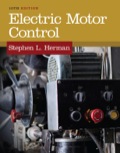
Concept explainers
Explain the procedure to engage and disengage the magnetic clutch.
Explanation of Solution
Discussion:
The clutches provide smooth start for the motors and engage the large motors to their loads. The clutches are able to control electrically. The clutches are categorized as single-face clutch and multiple-face clutch.
The single-face clutch consists of two discs that are field member and armature member. The field winding disc (field member) is an electromagnet. The field member and the armature member are brought together by applying the current to the field winding disc through slip rings (collector). The friction is produced when the current is applied to the field member and that friction tightly pulls the field member toward the armature member. That is, the clutches are engaged by applying the current to the field member through slip rings.
The field member and the armature member are
Refer Figure 56-3 in the textbook for the principle of operation of electrically controlled clutches.
Conclusion:
Thus, the procedure to engage and disengage the magnetic clutch is explained.
Want to see more full solutions like this?
Chapter 56 Solutions
Electric Motor Control
- i need helppp pleasearrow_forward1) (2pts) If you know you have a bad clock (lots of jitter) and you are not bandwidth constrained, you should: (Circle the correct answer) a) Set the roll off factor to zero b) Set the roll off factor to ½ c) Set the roll off factor to one 2) (2pts) Short answer: Why do we use M-ary modulation? 3) (4 pts) Short answer: The application engineer comes to your desk and says that the error rate is too high and must be reduced for the application to function correctly. The system is battery operated. What do you tell them is the trade- off?arrow_forwardi need helppp pleasearrow_forward
- 5) (20 pts) You are testing a system that has pulse shape shown below for Logic 1 and Logic 0. You are connecting the transmitter to an oscilloscope which is set up to display the resulting eye-diagram of the system. Sketch what you would expect to see on the oscilloscope for an ideal system (an ideal system is noiseless and jitter free) Logic 1 3 volts Time 0 Ть Logic 0 0 Ть Time -2 voltsarrow_forward4. (20 pts) You are given a channel with the following impulse response. Determine the set of equations that will be used to determine the coefficients of a Zero-Forcing Linear Equalizer. DO NOT SOLVE FOR THE COEFFICIENTS. Just show the set of equation that would be used to solved the coefficients. 0 m≤-31 -0.33 m = -2 .25 m = -1 h(mb) = 1 m = 0 -0.45 m = 1 0.5 m = 2 0 m≥3arrow_forwardI need help understanding part B. See attached photo.arrow_forward
- i need helppp pleasearrow_forward3) (30pts) An application requires a bit rate of 18.2 Kbps and an error rate of less than 104. The channel has a noise power spectral density of 10-8 W/Hz. The channel attenuates the power in the signal by 5 dB. The system uses binary PAM baseband digital communication system with the minimum required bandwidth and a roll-off factor of 0.319. a) (10 pts) What is the estimated minimum required signal power (Pt) at the transmitter?arrow_forwardi need helppp pleasearrow_forward
- i need helppp pleasearrow_forwardi need helppp pleasearrow_forward1a) (5pts) Suppose X is a Gaussian random variable with a mean of 2 and a variance of 9. What is the probability X is greater than 2. 1b) (5pts) Suppose X is a Gaussian random variable with a mean of 2 and a variance of 9. Using the Q-function, determine Prob{-4-2} Leave your answer in terms of the Q-function; do not evaluate it.arrow_forward

 Electricity for Refrigeration, Heating, and Air C...Mechanical EngineeringISBN:9781337399128Author:Russell E. SmithPublisher:Cengage Learning
Electricity for Refrigeration, Heating, and Air C...Mechanical EngineeringISBN:9781337399128Author:Russell E. SmithPublisher:Cengage Learning EBK ELECTRICAL WIRING RESIDENTIALElectrical EngineeringISBN:9781337516549Author:SimmonsPublisher:CENGAGE LEARNING - CONSIGNMENT
EBK ELECTRICAL WIRING RESIDENTIALElectrical EngineeringISBN:9781337516549Author:SimmonsPublisher:CENGAGE LEARNING - CONSIGNMENT


